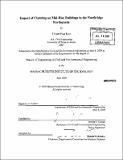Impact of cladding on mid-rise buildings in the Northridge Earthquake
Author(s)
Kuo, Chuan-Hua
DownloadFull printable version (18.71Mb)
Other Contributors
Massachusetts Institute of Technology. Dept. of Civil and Environmental Engineering.
Advisor
Jerome J. Connor.
Terms of use
Metadata
Show full item recordAbstract
In this thesis, the importance of cladding panels on mid-rise buildings in an earthquake-prone region is investigated. A cladding panel acts as a protective or an insulating layer to control weather infiltration. The Northridge Earthquake, which took place on January 17, 1994, caused numerous heavy cladding panels to fall off the walls of residential and commercial buildings. The failure of these panels was a result of an insufficient understanding of the cladding behaviors as a subsystem in the three-dimensional framing system. Cladding is designed to be isolated from the structural frame movement during an earthquake. However, numerous studies have concluded that cladding interacts with the structural frame in providing lateral resistance. The advantages and disadvantages of different cladding materials, cladding systems, and cladding connections are presented in this thesis. The effects of cladding on mid-rise buildings in the Northridge Earthquake in the Los Angeles area are simulated in this study. Motion resistance contributed from cladding in a particular mid-rise building, a 19-story office building in downtown Los Angeles, is investigated. Analyses of clad models and unclad models are carried out, and clad models are discovered to displace less than unclad models. Therefore, cladding is able to contribute lateral motion resistance to a building during an earthquake, and structural engineers should include cladding in their analysis models when designing a building.
Description
Thesis (M. Eng.)--Massachusetts Institute of Technology, Dept. of Civil and Environmental Engineering, 2009. Includes bibliographical references (p. 58-59).
Date issued
2009Department
Massachusetts Institute of Technology. Department of Civil and Environmental EngineeringPublisher
Massachusetts Institute of Technology
Keywords
Civil and Environmental Engineering.